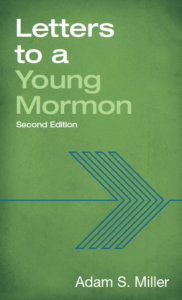 Review
Review
Title: Letters to a Young Mormon, Second Edition
Author: Adam S. Miller
Publisher: Deseret Book
Genre: Religion
Year Published: 2018
Number of Pages: 97 + ix
Binding: Paperback
Price: $9.99
Reviewed by Jenny Webb for the Association for Mormon Letters
This book is incredibly difficult to describe, let alone convey, in the format of a book review. Its short length (only ninety-seven pages, even in its expanded form here in the second edition) and relatively small size (you could slip it into your scripture case and no one would be the wiser) belie the depth and breadth as well as the clarity and complexity of its subject matter, which is simply “the real beauty and real costs of trying to live a Mormon life. And . . . something of what it means to live in a way that refuses to abandon either life or Mormonism” (xi).
Miller is a philosophy professor whose work has centered around topics such as grace and scripture (see, e.g., his incredibly sharp, rigorous treatment of Latour in Speculative Grace: Bruno Latour and Object-Oriented Theology and his thoughtful reading of Paul in Grace is Not God’s Backup Plan: An Urgent Paraphrase of Paul’s Letter to the Romans). He is also the director of the Mormon Theology Seminar, where, along with associate director Joseph M. Spencer (whose own recent The Vision of All: Twenty-Five Lectures on Isaiah in Nephi’s Record should be required reading for anyone working on scripture and Mormonism), he oversees an annual summer seminar devoted to an intensive, close reading of a single chapter of scripture over the course of two weeks. In other words, Miller is a man who has spent a life learning to read, think, and write about all kinds of texts. And in Letters to a Young Mormon, he puts those skills to work reading Mormonism itself.
The result is a series of brief but powerful letters covering fourteen topics: agency, work, sin, faith, scripture, prayer, sabbath, history, science, stewardship, hunger, sex, temples, and eternal life. They are lean letters, stripped of any unnecessarily florid gestures, where each word acts together with the rest in a generative, life-giving network: marrow in the bone of Mormonism.
And they are, despite what one might expect given Miller’s academic background, deeply personal. The tone, language, and images are both intimate and direct. The prose is almost poetic at times—it’s a book that is hard to put down. There’s a reason for this personal approach: the entire project is, in a sense, grounded in the relationship of a father to his children. He writes each letter addressed to his daughter—”Dear S.,”—and signs each as himself—Love, A.” In 2017, Miller articulated his hope that the book would help his children: “that they’ll be able to see more clearly why it is I love Mormonism so much and why I think living this kind of life is worth all the trouble and difficulty and effort. [. . .] I hope that it will prompt them to make the same decision that Mormonism . . . with whatever difficulties are involved in trying to live it, that it’s worth it.”[1]
Beyond this basic approach, Miller develops several repeating themes over the course of the book. It’s ok to not know things—a lack of knowledge is an invitation to keep questioning, learning, and seeking. You are the only one who can live your life, and as such, you are a pioneer. Focus on the present, on the task at hand—if you’re always focused on the future, you will miss your own life. Everyone sins, and only God can save; but God doesn’t save us from doing sinful acts so much as from living a sinful life. To live a sinful life is to live our lives according to what Miller calls our “stories”—the things we tell ourselves about ourselves, who we think we are, what we think is important—and when we prefer our stories over the eternal, graced life God is trying to give us right here, and right now.
And over and over again for Miller, things are not necessarily what we think they are: faith isn’t sure; scriptures should be translated and not merely read; prayer isn’t just talking; the Sabbath doesn’t mark time, but ends it; history isn’t golden; science makes God bigger, not smaller; stewardship isn’t optional; bodies matter, and are matter. In the words of Jesus via Miller, “don’t expect . . . the kingdom of God to look like a massive oak tree. Expect it to be more like a weed that, without your quite intending it, overruns your garden and crowds out the stories you’d been hoping to tell” (52).
He explores the immediacy of God here on the earth and in our own lives now. For Miller, Mormonism points us to the ways in which our flesh and our relationships participate in and as eternal lives as we live them. Christ didn’t come to condemn us to a life spent longing for difference, but rather to teach us how to live our lives in the rest of the Lord.
In other words, the letters Miller writes here convey a Mormonism centered on the grace we receive now and how it frees us to live Christ’s life in charity.
I have no hesitation in recommending this slim, beautiful volume to anyone. Young or old, Mormon or not—this is the kind of work that can be read and re-read throughout a lifetime. And will be.
A final note: If you picked up the first edition back in 2014 and are wondering whether this new edition is worth acquiring, my opinion is a firm yes. Not only are the two new letters on the Sabbath and stewardship worth reading, but the new cover and the production quality of the book are vast improvements over the first edition.
NOTE
- Morgan Jones, “The Man Behind the Pen of ‘Letters to a Young Mormon,'” Deseret News, Jan. 1, 2017, https://www.deseretnews.com/article/865694594/The-man-behind-the-pen-of-Letters-to-a-Young-Mormon.html.
